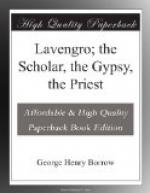It only takes five years to make an attorney, and Borrow ought therefore, had he served out his time, to have become a gentleman by Act of Parliament in 1824 or 1825. He did not do so, though he appears to have remained in Norwich until after 1826. In that year appeared his Romantic Ballads from the Danish, printed by Simon Wilkins of Norwich by subscription. Dr. Jessopp opines that the Romantic Ballads must have brought their translator ’a very respectable sum after paying all the expenses of publication.’ I hope it was so, but, as Dr. Johnson once said about the immortality of the soul, I should like more evidence of it. When Borrow left Norwich for London, it is hard to say. It was after the death of his father, and was not likely to have been later than 1828. His only introduction appears to have been one from William Taylor to Sir Richard Phillips, ‘the publisher’ known to all readers of Lavengro. Sir Richard was one of the sheriffs of London and Middlesex, and in addition to sundry treatises on the duties of juries, was the author of two lucubrations, respectively entitled The Phaenomena called by the name of Gravitation proved to be Proximate Effects of the Orbicular and Rotary Motions of the Earth and On the New Theory of the System of the Universe. In Watt’s Bibliotheca Britannica, 1824, Sir Richard is thus contemptuously referred to: ’This personage is the editor of The Monthly Magazine, in which many of his effusions may be found with the signature of “Common Sense."’ It is not too much to say that but for Borrow this




